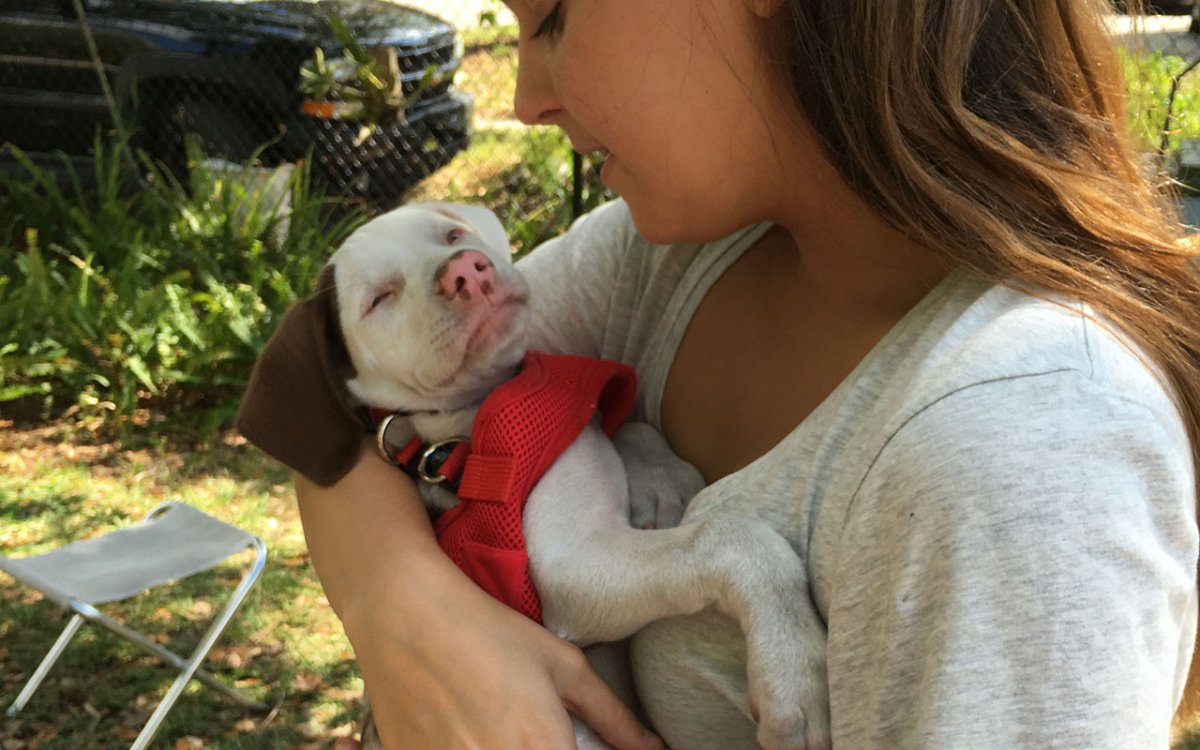Meet Ruby – the lovable therapy dog from Apollo Beach, Fla., who’s one-of-a-kind, to say the least. Why? Well Ruby can’t hear or see.

But that isn’t stopping her from stealing hearts and bringing smiles to the faces of people she loves – and social media.
“She acts like a typical dog,” Erin Baxter, Ruby’s owner, says. “She runs around and plays. She’s so affectionate and always wants to be near somebody or touching you. That’s her comfort. She feels safe and secure when she’s near you.”
Ruby’s journey to become the unique therapy dog that she is began last April.
Baxter and her family had just lost their family dog Scarlet to old age and were still dealing with the heartbreak of her death. One night, a week later while browsing Facebook, however, Baxter came across a story about how the Humane Society in Fort Myers was looking to find homes for three blind and deaf puppies that had come in to their possession.
READ MORE: ‘I died today’: Photos of dog’s last day on earth go viral
“We weren’t even thinking about adopting a dog at that time because the loss of Scarlet was still so fresh and new,” Baxter says. “But I went to sleep that night and I couldn’t stop thinking about them.”
- Invasive strep: ‘Don’t wait’ to seek care, N.S. woman warns on long road to recovery
- Grocery code: How Ottawa has tried to get Loblaw, Walmart on board
- ‘Super lice’ are becoming more resistant to chemical shampoos. What to use instead
- Canadian food banks are on the brink: ‘This is not a sustainable situation’
That weekend, Baxter, her husband, and two of her three daughters, drove two hours to visit the puppies at their foster home.
When they arrived, the puppies were asleep. But when Baxter’s daughter Avery sat on the floor, one of the puppies, a Louisiana Catahoula Leopard breed, woke up and climbed on to her lap. It was wearing a red collar – and immediately, Baxter thought it was fate.
“It hit me – Scarlet was named Scarlet because when we got her, her collar was red, so we named her Scarlet,” Baxter says. “And Ruby was wearing red and I thought right away that this was meant to be.”
It took no time at all for Ruby to feel at home, and it was apparent she enchanted anyone she’d meet.
One thing that stood out to Baxter was Ruby’s way of comforting others, by pressing the weight of her body against whoever she’s cuddling.
So Baxter got the idea that perhaps Ruby would make the perfect therapy dog.
But first she needed to find someone who’d be able to train Ruby, for both obedience and (later on) as a therapy dog.
Eventually Baxter found Rick Carde who owned a dog training centre called Tampa Bay K-9 Solutions. And while he had trained deaf dogs and blind dogs in the past, he (along with many other trainers) had never trained an animal that was both blind and deaf. So Rick had to get creative.
“It took a little bit of trial and error,” Carde explains. “Because there’s no chapter in the training manual for how to train blind and deaf dogs so I had to think outside the box.”
Rick started with narrowing down the senses she had: smell, touch and taste.
At first, Rick wanted to see if attaching commands to a specific scent would work, but he had to find one that Ruby wouldn’t often smell. The idea was working, but not efficiently enough.
Rick said that because she relied on smell as her primary sense, she would become over-stimulated in certain situations and wasn’t able to narrow down that one scent.
So Rick went on to plan B: using a vibrating collar. This proved to be the most successful at getting Ruby to stop and sit, on command.
READ MORE: Mom’s Facebook video of bullied children goes viral
Pressure proved to be another successful tactic. For example, a touch between Ruby’s shoulders means to lay down, and a stroke underneath her chin means to follow.
And now that Ruby has mastered basic obedience, she has graduated to training as a therapy dog.
Rick is coming up with new training methods to teach Ruby general therapy-dog skills, like self-control and focus, among other skills.
Ruby’s already been doing some training rounds within the community, and people can’t help but fall in love with her.
And one day, Baxter and Carde hope that she will be able to bring comfort to patients in hospitals and veterans with PTSD.
“You have to meet Ruby to understand,” Carde says. “It’s an overwhelming feeling when she’s just in your lap and giving you her full attention. She makes you feel different… The minute you meet her, you’re like, ‘I get it.’”







Comments